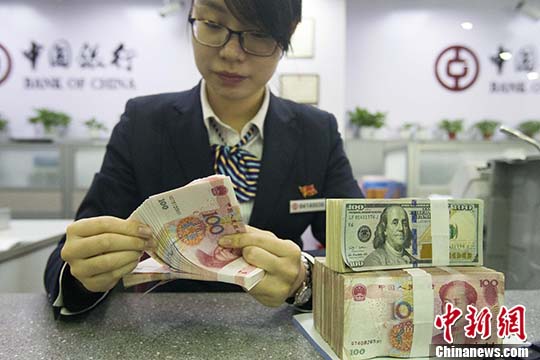Chinanews.com, March 22. Xuan Changneng, deputy director of the State Administration of Foreign Exchange, pointed out on March 22 that data shows that, despite the impact of the epidemic, China ’s foreign exchange market has been operating smoothly and the RMB exchange rate has remained stable.
Data Map: Bank staff are counting currency. China News Agency reporter Zhang Yunshe
The State Council Information Office held a press conference on March 22 to introduce relevant situations in response to the impact of the international epidemic and maintaining financial market stability.
Xuan Changneng introduced at the meeting that since the outbreak of the new crown pneumonia epidemic, the State Administration of Foreign Exchange has continued to help fight the epidemic and actively support enterprises to resume work and resume production. Data show that, despite the impact of the epidemic, China's foreign exchange market has been operating steadily since this year.
In terms of foreign exchange support policies, Xuan Changneng introduced that the SAFE has always made epidemic prevention and control and support for the resumption of production and production of enterprises as the top priority of its current work. It carefully listens to the demands of enterprises and other market entities and helps solve problems encountered in foreign exchange. Increase support for foreign exchange policies.
First, continue to make good use of the "green channel" policy of foreign exchange, and actively support the prevention and control of epidemics and the resumption of production and work.
The second is to improve macro-prudential adjustment parameters and expand the space for enterprises to borrow foreign debt. On March 12, the People's Bank of China and the Foreign Exchange Bureau issued a joint document to raise the macro-prudential adjustment parameter from 1 to 1.25%. After the policy adjustment, the upper limit of the risk-weighted balance of cross-border financing for enterprises has been increased from 2 times the original net assets to 2.5 times. The space for foreign debt borrowing by domestic institutions other than government financing platforms and real estate companies has further expanded, which is beneficial to SMEs and private enterprises. Raise funds through various international and domestic channels.
The third is to expand the pilot of foreign debt facilitation and support cross-border financing of high-tech enterprises. The pilot scope of foreign debt facilitation will be expanded to Shanghai, Hubei, Guangdong, and Shenzhen to allow high-tech enterprises that meet certain conditions to borrow foreign debt independently within the equivalent of USD 5 million. At the same time, the level of facilitation of foreign debts in Haidian Park, Zhongguancun Science City, Beijing was further improved to better meet the needs of high-tech enterprises in many places using external debt funds and reduce corporate financial costs.
The fourth is to actively use technical means such as cross-border financial blockchain platforms to facilitate trade financing for SMEs.
Xuan Changneng pointed out that, overall, despite the impact of the epidemic this year, China ’s cross-border capital flows have been generally stable, and the foreign exchange market has basically balanced supply and demand.
First, the RMB exchange rate fluctuated in both directions within a reasonable range. Since this year, the RMB exchange rate has generally remained stable. As of March 20, the spot RMB transaction price in China had depreciated by 1.4%, while the US dollar index had risen by 5.2%. The emerging market currency index fell by 13.4%, of which the international financial market has fluctuated sharply since late February. From February 21 to March 20, the domestic spot RMB transaction price depreciated by 0.7%, while the emerging market currency index fell by 10%, of which In late March, the depreciation of the renminbi was also significantly smaller than that of currencies such as the euro and the pound during the same period. These data fully show the relatively stable performance of the RMB exchange rate in the global foreign exchange market, especially in emerging markets.
Second, the supply and demand of the foreign exchange market has remained basically balanced. From January to February, China's banks had a surplus of USD 20.6 billion in foreign exchange settlement and sales, and a balance of USD 18.7 billion in the non-bank sector's foreign-related revenue and expenditure surplus. After comprehensive consideration of other supply and demand factors such as forward options, the foreign exchange market supply and demand showed a basic balance.
Third, foreign exchange reserves remained generally stable. As of the end of February, the size of China's foreign exchange reserves was 316.7 billion US dollars, which remained stable overall.
Xuan Changneng also pointed out that due to the global spread of the new crown pneumonia epidemic and the sharp decline in international crude oil prices, the recent turbulence in the international financial market has increased. In response to this, the State Administration of Foreign Exchange will strengthen monitoring and respond appropriately.
In the next step, the State Administration of Foreign Exchange will accelerate the implementation of various cross-border trade and investment facilitation measures to achieve results, continue to optimize the foreign exchange business environment, and better serve the recovery of the real economy. At the same time, we will further improve the integrated management framework of "macro-prudential + micro-regulation" in the foreign exchange market, prevent cross-border capital flow risks, and maintain national economic and financial security.

